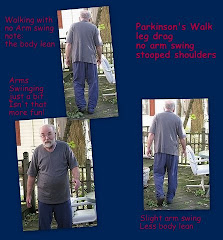
Okay - we know that good breathing techniques help the throat, lungs, ribcage maintain elasticity. And we know that stiffness is a serious issue in Parkinson's disease. We know that breathing through our noses is much healthier for us.
Let's begin by checking your type of breathing.
What drives each breath?
Try this first sitting upright and then repeat while lying on your back:
Place your left hand just below your breastbone - not on your stomach, that's too low.
The right palm is placed somewhere below the top of the sternum but higher than your heart.
Breathe normally.
Which hand is moving? Left? Right? Both?
The goal is that your left hand - the one that is over your diaphragm - is the only one which feels movement.
If it is, fantastic. If it isn't, let's make it happen.
Some of these exercises can be done while you're working at your desk, in the car, in the shower (hopefully on a shower seat if your balance is poor) Turn on whatever makes music for you and do them to rhythm. Music can be very helpful to making an unconscious change in breathing patterns. Right now we are peaceful. You might want to have a partner read the exercise instructions to you.
Breathe and Hum
Sittiing upright or in a straight chair
Exhale slowly
Inhale and let your stomach muscles relax to expand and take in air
Hold your breath and then slowly exhale
As the air is released, let your rib cage relax - you can pull your stomach muscles in to force out the remaining air.
Close your eyes - just focus on your breathing
Center in on just being there with your breathing
Don't allow your upper chest to become tense - feel the air coming in through your nose
Breathe out slowly
Let your own breath warm and relax you
Now add to the exhale a HUMMING sound.
Think of it as your mantra and continue to pull your stomach muscles in to make the hum last longer.
How low can you go?
You will be able to feel if the hum is coming from your nasal passages (high) or lower in your throat.
The lower the better because that tells you that the expulsion of air from your lungs is driving the hum.
Whoosh can be done anywhere; it is relaxing and simple:
Exhale completely through your mouth, making a whoosh sound.
Close your mouth and inhale quietly through your nose to a silent count of 4
Hold your breath for a count of 7.
Exhale completely through your mouth, making a whoosh sound to a count of 8
This is one breath.
Now inhale again and repeat the cycle three more times for a total of four breaths.
Note: your exhale is twice as long as the inhale.
Next let’s use the arms as an active part of a breathing exercise.
This short (though not shallow) breath exercise comes from Tai Chi Chuan.
The use of your arms will aid in opening the shoulders, rib cage and free the diaphragm
Sniffing the air to open your body
Three short inhales are done through the nose without exhaling.
On the first inhale, the arms are lifted from the sides straight out in front at shoulder height.
On the second, the arms are opened out straight to the sides while still at shoulder height.
And on the third, the arms are lifted straight over the head.
Then, on the exhale through the mouth, the arms are moved in an arc back down to the sides.
Usually, ten or twelve breaths are sufficient and will not cause light headedness - but if they do, stop.
Caution for older folks: never do panting or shallow breathing in a standing position as hyperventilation can occur.
As long as you are seated, you should be safe because even if a brief blackout should occur,the body's automatic breathing will immediately kick in.
The Zen of breath counting
Sit up in a comfortable position - your spine as straight as possible, head slightly forward
Close your eyes slowly and take a few deep breaths - naturally from the diaphragm and through your nose - quietly and slowly
Count "1" to yourself as you exhale
The next time count "2" as you exhale and continue until "5"
Begin a new cycle of 5. Count only when you exhale
Try to do this for 10 minutes as a form of meditation.
Tomorrow we'll try a Yoga exercise and Buteyko Shallow Breathing.
If done correctly, you may feel invigorated by these exercises, you may feel calmer.
You are exercising your diaphragm which may feel strange at first but muscle expansion and contractibility is crucial.
What is important is getting to the basics of breathing for a healthier you.
See you tomorrow














No comments:
Post a Comment
Welcome to Parkinsons Focus Today.
We are delighted to hear from you by comment here
or through email as found in Contact Us.
Please do not include email addresses if leaving a comment online.
Email addresses are used only for email responses.
Spammers take note: your messages will not be published. The comments section is for an exchange of ideas, not for backlinks.